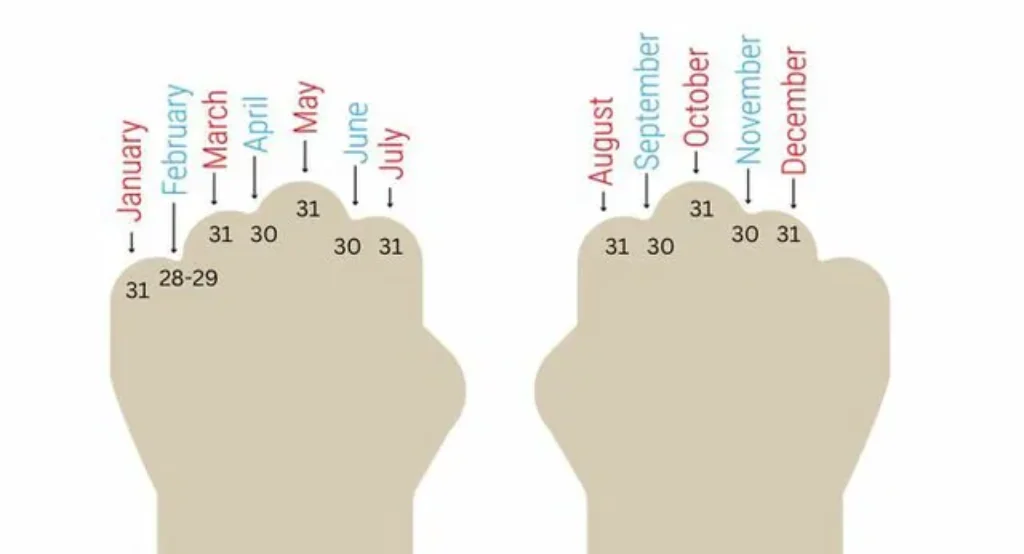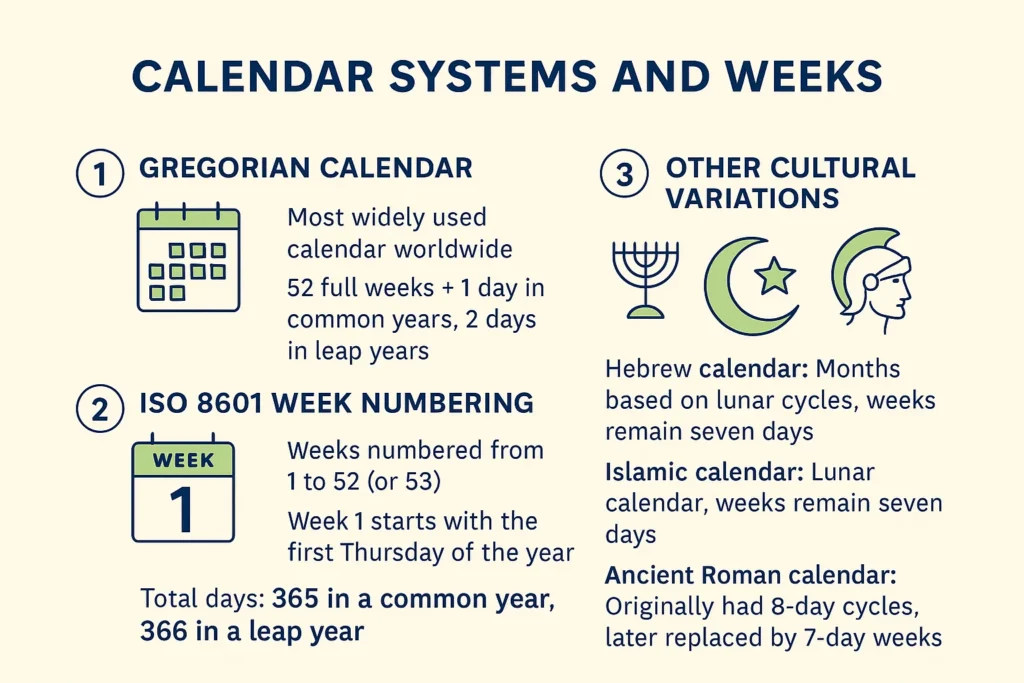
Executive Summary
Understanding how many weeks are in a year is a fundamental concept in time management, planning, finance, and education. A year is commonly divided into weeks, months, and days, but the exact number of weeks in a year can vary depending on whether it is a common year or a leap year.
This guide explores the mathematical calculation of weeks in a year, historical context of calendars, practical applications in personal and professional life, variations across cultures and systems, and interesting facts about weeks, years, and time measurement.
Table of Content
1. Defining a Year
1.1 What is a Year?
A year is a unit of time that approximates the Earth’s orbital period around the Sun. It is the basis for calendars used worldwide and is divided into months, weeks, and days for daily, monthly, and yearly planning.
- Common year: 365 days
- Leap year: 366 days, occurring every four years to account for the extra ~0.2422 days in the solar year
1.2 Importance of Measuring a Year
Understanding a year’s duration is critical for:
- Calendars and scheduling
- Financial planning and accounting
- Education semesters and academic planning
- Project management and long-term goal setting
- Agriculture and seasonal activities
2. Understanding a Week
2.1 What is a Week?
A week is a unit of time consisting of seven days. It is widely used across societies to organize work, rest, religious practices, and personal schedules.
- Days of the week: Monday, Tuesday, Wednesday, Thursday, Friday, Saturday, Sunday
- Origin: The seven-day week has historical roots in Babylonian astronomy, Jewish traditions, and Roman adoption of the Julian calendar
2.2 The Role of Weeks in Modern Society
- Work planning: Standard workweek is typically 5 days (Monday–Friday)
- School schedules: Academic weeks follow structured daily lessons
- Financial cycles: Many financial statements, payrolls, and budgets are calculated weekly
- Cultural and religious observances: Sabbath, Sunday, or other weekly rituals
3. Calculating Weeks in a Year
3.1 Basic Calculation
A week consists of 7 days, and a common year has 365 days. To calculate the number of weeks in a year: Weeks in a year=Number of days in a yearNumber of days in a week\text{Weeks in a year} = \frac{\text{Number of days in a year}}{\text{Number of days in a week}}Weeks in a year=Number of days in a weekNumber of days in a year
- Common year:
3657≈52.142857 weeks\frac{365}{7} \approx 52.142857 \text{ weeks}7365≈52.142857 weeks
- Leap year:
3667≈52.285714 weeks\frac{366}{7} \approx 52.285714 \text{ weeks}7366≈52.285714 weeks
Observation: A year is not exactly 52 full weeks, but approximately 52 weeks and 1 day in a common year and 52 weeks and 2 days in a leap year.
3.2 Practical Representation
- Common year: 52 weeks + 1 extra day
- Leap year: 52 weeks + 2 extra days
These extra days explain why the calendar shifts every year. For example, if January 1 is a Monday in a common year, the next year it will start on a Tuesday.
Related Reads You’ll Enjoy
If you’re curious about time, productivity, and how the calendar affects learning or work planning, check out these helpful guides:
- How Many Weeks Are in a School Year – Understand how academic calendars are structured around weeks, terms, and breaks.
- Why Is Time Management Important – Discover why managing your time wisely boosts productivity and reduces stress.
- What Is Time Management – Learn the core principles and techniques of effective time management.
- What Is Business Management – See how professionals use structured time planning in managing teams and goals.
- How to Become an Influencer – Explore how successful creators manage content schedules and consistency over time.
4. Weeks, Months, and Days Relationship
4.1 Days in Each Month
A typical Gregorian calendar year consists of:

- January: 31 days
- February: 28 days (29 in leap year)
- March: 31 days
- April: 30 days
- May: 31 days
- June: 30 days
- July: 31 days
- August: 31 days
- September: 30 days
- October: 31 days
- November: 30 days
- December: 31 days
Total days: 365 in a common year, 366 in a leap year
4.2 Converting Months to Weeks
Since months vary in days, weeks in a month are approximate:
- 28-day month: 4 weeks
- 30-day month: 4 weeks + 2 days
- 31-day month: 4 weeks + 3 days
Therefore: A year is roughly 52 weeks and 1 day, aligning with the earlier calculation.
5. Leap Years and Their Impact on Weeks
5.1 What is a Leap Year?
A leap year has 366 days instead of 365. It occurs every four years, except for years divisible by 100 but not by 400.
- Example: 2020 was a leap year, 2024 will be the next
- Leap years keep the calendar year synchronized with the solar year
5.2 Weeks in a Leap Year
3667≈52 weeks +2 days\frac{366}{7} \approx 52 \text{ weeks } + 2 \text{ days}7366≈52 weeks +2 days
Leap years slightly adjust weekly schedules, impacting payroll, project planning, and annual events.
6. Historical Perspective on Weeks
6.1 Origins of the 7-Day Week
- Babylonians: Introduced seven-day cycles based on the seven celestial bodies visible to the naked eye
- Hebrews: Adopted the seven-day week with the Sabbath as the day of rest
- Romans: Later integrated seven-day weeks into the Julian calendar
6.2 Modern Standardization
- The Gregorian calendar, introduced in 1582, maintained the seven-day week
- ISO 8601 standard defines Monday as the first day of the week in international usage
7. Practical Applications of Weeks in a Year
7.1 Personal Planning
- Scheduling vacations, appointments, and personal goals
- Tracking weekly exercise, diet, and productivity habits
7.2 Education
- Academic semesters and courses are planned in weeks
- Example: A 16-week semester aligns with lecture schedules, exams, and holidays
7.3 Financial Planning
- Payroll: Weekly, biweekly, and monthly payments
- Budgeting: Weekly tracking of expenses and savings
7.4 Project Management
- Projects are divided into weekly sprints for progress tracking
- Agile methodologies often use 1–4 week sprints
8. Calendar Systems and Weeks

8.1 Gregorian Calendar
- Most widely used calendar worldwide
- 52 full weeks + 1 day in common years, 2 days in leap years
8.2 ISO 8601 Week Numbering
- Weeks numbered from 1 to 52 (or 53)
- Week 1 starts with the first Thursday of the year
8.3 Other Cultural Variations
- Hebrew calendar: Months based on lunar cycles, weeks remain seven days
- Islamic calendar: Lunar calendar, weeks remain seven days
- Ancient Roman calendar: Originally had 8-day cycles, later replaced by 7-day weeks
9. Weeks in a Year: Interesting Facts
- There are approximately 52.1775 weeks per year on average, accounting for leap years
- Some years may have 53 weeks depending on the day of the week the year starts and ends
- Week numbers are often used in business and accounting to standardize reporting
10. Mathematical Considerations
10.1 Average Weeks per Year
Considering leap years occur every 4 years, the average number of days per year is: 3×365+3664=365.25 days/year\frac{3 \times 365 + 366}{4} = 365.25 \text{ days/year}43×365+366=365.25 days/year
Dividing by 7 days per week: 365.257≈52.1786 weeks/year\frac{365.25}{7} \approx 52.1786 \text{ weeks/year}7365.25≈52.1786 weeks/year
10.2 Week Overlaps
- Extra days beyond 52 weeks cause the day-of-week to shift each year
- In long-term planning, these extra days affect recurring annual events
11. Weeks in Professional Contexts
11.1 Business Planning
- Fiscal year planning often considers 52 weeks
- Companies use weekly sales reports, inventory checks, and operational reviews
11.2 Healthcare and Shift Work
- Hospitals and emergency services rely on weekly schedules for staff rotations
- Tracking patient care and staffing levels is based on weekly cycles
11.3 Agriculture
- Crop cycles and seasonal work are often tracked in weekly intervals
- Planning for planting, irrigation, and harvesting often uses a week-based schedule
12. FAQs
12.1 How many weeks in a leap year?
- 52 weeks and 2 days
12.2 Can a year have 53 weeks?
- Yes, if the year starts on Thursday (common year) or Wednesday/Thursday (leap year)
12.3 How is the week number calculated?
- According to ISO 8601, Week 1 contains the first Thursday of the year
12.4 Why are weeks 7 days long?
- Historical and astronomical reasons, linked to lunar cycles and celestial observations
12.5 How to calculate weeks for a custom date range?
- Count the total number of days and divide by 7, rounding as necessary for partial weeks
13. Conclusion
A year contains approximately 52 weeks, with extra days accounting for calendar adjustments. Understanding weeks in a year is crucial for personal planning, business operations, education, healthcare, finance, and agriculture.
- Common year: 52 weeks + 1 day
- Leap year: 52 weeks + 2 days
- Average over four years: 52.1786 weeks/year
Weeks serve as a universal tool for structuring time, organizing schedules, and ensuring consistency across global activities. Mastery of this concept is essential for effective time management and planning.


